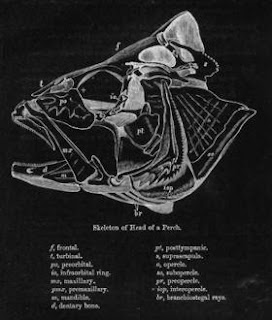Fish anatomy is primarily governed by the physical characteristics of water, which is much denser than air, holds a relatively small amount of dissolved oxygen, and absorbs light more than air does.

Lampanyctodes hectoris
(1) - operculum (gill cover), (2) - lateral line, (3) - dorsal fin, (4) - adipose fin, (5) - caudal peduncle, (6) - caudal fin, (7) - anal fin, (8) - photophores, (9) - pelvic fins (paired), (10) - pectoral fins (paired)
Body
Fish have a variety of different body plans. Their body is divided into head, trunk, and tail, although the divisions are not always externally visible. The body is often fusiform, a streamlined body plan often found in fast-moving fish. They may also be filiform (eel-shaped) or vermiform (worm-shaped). Also, fish are often either laterally compressed (thin) or vertically depressed (flat).
The caudal peduncle is the narrow part of the fish's body to which the caudal or tail fin is attached. The hypural joint is the joint between the caudal fin and the last of the vertebrae. The hypural is often fan-shaped.
Photophores are light-emitting organs which appears as luminous spots on some fishes. The light can be produced from compounds during the digestion of prey, from specialized mitochondrial cells in the organism called photocytes, or associated with symbiotic bacteria, and are used for attracting food or confusing predators.
The lateral line is a sense organ used to detect movement and vibration in the surrounding water. In most species, it consists of a line of receptors running along each side of the fish.
The ampullae of Lorenzini allow sharks to sense electrical discharges.
The genital papilla is a small, fleshy tube behind the anus in some fishes, from which the sperm or eggs are released; the sex of a fish often can be determined by the shape of its papilla.
Head

The head includes the snout, from the eye to the forwardmost point of the upper jaw, the operculum or gill cover (absent in sharks), and the cheek, which extends from eye to preopercle. The operculum and preopercle may or may not have spines. The lower jaw defines a chin.
In lampreys, the mouth is formed into an oral disk. In most jawed fish, however, there are three general configurations. The mouth may be on the forward end of the head (terminal), may be upturned (superior), or may be turned downwards or on the bottom of the fish (subterminal or inferior). The mouth may be modified into a suckermouth adapted for clinging onto objects in fast-moving water.
The head may have several fleshy structures known as barbels, which may be very long and resemble whiskers. Many fish species also have a variety of protrusions or spines on the head. The nostrils or nares of almost all fishes do not connect to the oral cavity, but are pits of varying shape and depth.